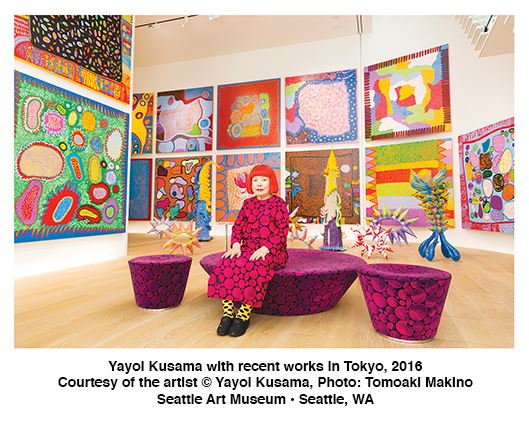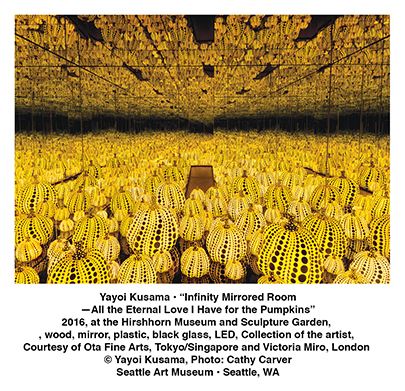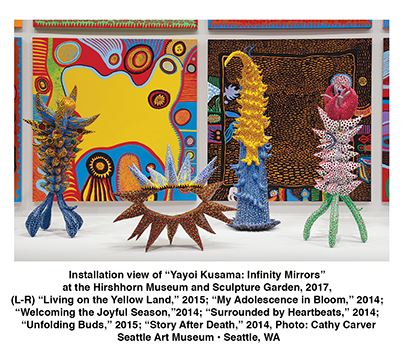
I have a confession. At the time of this writing, I have not seen “Yayoi Kusama: Infinity Mirrors” at the Seattle Art Museum. In fact, I’ve never seen Kusama’s work in a museum or gallery.
And yet, I have seen it. The images of Kusama’s work precede her. They’re everywhere: I’ve seen them in my art history books, on the Internet, in the barrage of promotional materials from SAM over the last few months. Oh, and of course, on Instagram.
Kusama’s Infinity Mirror Rooms, the artworks for which she has become best known, are a selfie-lover’s dream come true. The rooms are fully immersive spaces where visitors enter one or a few at a time, close the door behind them, and are surrounded on all sides by mirrors. Often, the spaces are filled with sculptural objects like her signature polka dot pumpkins or stuffed tubers. Once inside, these intimate spaces can simulate a feeling of being in the infinite (or so I’ve been told). One of my friends even described his first time in an Infinity Room as a “cosmic experience.” 
Kusama made her first Infinity Mirror Room in 1965. And she’s continued making them. Today, a kind of frenetic craze has built up around them. Kusama is also a prolific painter, sculptor, performance, and video artist, but right now, her Infinity Rooms are all the rage.
When the exhibit was at the Hirshhorn in Washington, D.C., earlier this year, the museum broke all kinds of attendance records, with 32,500 visitors in the first week alone. In Seattle, the buzz has been building for months, and when advance tickets for the SAM show went on sale last month, they sold out in less than 24 hours.
What’s the draw? What is it about these Infinity Rooms that’s getting people to stand in line for hours to get inside one of Kusama’s mirrored rooms, knowing they might only be allowed 20 seconds once they’re in? Why the hype?
I think the answer has something to do with social media, and a lot to do with Instagram. It’s not a stretch to say that Kusama’s Infinity Mirror Rooms have become an Internet sensation. Search the hashtags #yayoikusama or #infinityroom and you’ll get over 400,000 posts—hundreds of thousands of selfies and video shorts of people standing in these expansive-looking spaces, surrounded on all sides by sparkling lights or pumpkins and polka dots. Someone at the Hirshhorn even broke one of the pumpkins in an Infinity Room back in February, reportedly because he was distracted while trying to take a selfie. Everyone wants to get their photo inside an Infinity Room. Because let’s face it, they photograph pretty dang well. That’s how Kusama intended it.
 Kusama is known for her embrace of the camera, unabashedly promoting herself and her work through images. Much like her fellow pop artists Andy Warhol and Keith Haring, Kusama has found a popular following that lives outside the traditional boundaries of the art world. Her astute understanding of the powers of publicity has lead to her immense popularity—in 2014, museum attendance records identified her as the most popular artist in the world. Over the course of her 65-year career, Kusama has worked hard to craft an identity that can be easily dispersed and digested in a culture of images.
Kusama is known for her embrace of the camera, unabashedly promoting herself and her work through images. Much like her fellow pop artists Andy Warhol and Keith Haring, Kusama has found a popular following that lives outside the traditional boundaries of the art world. Her astute understanding of the powers of publicity has lead to her immense popularity—in 2014, museum attendance records identified her as the most popular artist in the world. Over the course of her 65-year career, Kusama has worked hard to craft an identity that can be easily dispersed and digested in a culture of images.
Today we often look to images to locate our sense of self-identity, but for Kusama, this duplication and mirroring is a means of melting away the boundaries of self. It is a means of merging with the infinite. In the 1960s, this line of thought had a lot to do with that era’s counterculture movement. Her early performances from that time were just as much about making a political statement as they were about making art. Then, Kusama’s fantasy of a shared body and erasure of individual difference could be read as a means of fighting against the flattening effects of capitalism. “Become one with eternity,” she wrote in 1968 for her first “Self-Obliteration” performance. “Forget yourself. Self-destruction is the only way out…”
But today, Kusama’s work and the craze for its reproduction in selfies is hitting a different note. Rather than expanding social consciousness or serving as a vehicle for political commentary, it just feels flattening. Her work is being reduced to an image, and not in a good way. Snap a pic inside one of her rooms, post it to your Gram, and watch the likes roll in. Kusama’s Infinity Rooms have become yet another example of our unquenchable thirst for the easily-consumable image.
But perhaps this is what Kusama’s work has been about all along. From the beginning of her career, she’s been exploring reproduction as a means of self-dissolution. And isn’t that exactly what the selfie is doing today? We are duplicating ourselves, ad infinitum, on that tiny screen on our phones. Our identities have become a series of images and profiles that live on the Internet—on Instagram, Facebook, LinkedIn, Snapchat. More so than ever before, our conception of self lives in a reproduction, in an image.
Kusama’s work asks us to examine this reproduction, to question where the reality lies. Her Infinity Rooms beg to be photographed, but as soon as we do, we’re faced with our own reflection—we see ourselves taking a picture. Seducing us with the promise of the perfect selfie, Kusama forces us to catch ourselves in the act of looking. At ourselves.
Lauren Gallow
Lauren Gallow is an arts writer, critic, and editor. You can read more of her work at www.desert-jewels.com/writing.
“Yayoi Kusama: Infinity Mirrors” is on view through September 10 at the Seattle Art Museum, located at 1300 First Avenue in Seattle, Washington. Hours are Monday, Wednesday, and Friday through Sunday from 10 A.M. to 5 P.M.; Thursdays from 10 A.M. to 9 P.M.; and closed Tuesdays. For more information, call (206) 748-9287 or visit www.seattleartmuseum.org.